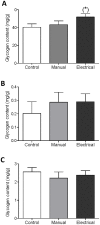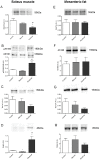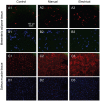Electrical vs manual acupuncture stimulation in a rat model of polycystic ovary syndrome: different effects on muscle and fat tissue insulin signaling
- PMID: 23349861
- PMCID: PMC3548783
- DOI: 10.1371/journal.pone.0054357
Electrical vs manual acupuncture stimulation in a rat model of polycystic ovary syndrome: different effects on muscle and fat tissue insulin signaling
Abstract
In rats with dihydrotestosterone (DHT)-induced polycystic ovary syndrome (PCOS), repeated low-frequency electrical stimulation of acupuncture needles restores whole-body insulin sensitivity measured by euglycemic hyperinsulinemic clamp. We hypothesized that electrical stimulation causing muscle contractions and manual stimulation causing needle sensation have different effects on insulin sensitivity and related signaling pathways in skeletal muscle and adipose tissue, with electrical stimulation being more effective in DHT-induced PCOS rats. From age 70 days, rats received manual or low-frequency electrical stimulation of needles in abdominal and hind limb muscle five times/wk for 4-5 wks; controls were handled but untreated rats. Low-frequency electrical stimulation modified gene expression (decreased Tbc1d1 in soleus, increased Nr4a3 in mesenteric fat) and protein expression (increased pAS160/AS160, Nr4a3 and decreased GLUT4) by western blot and increased GLUT4 expression by immunohistochemistry in soleus muscle; glucose clearance during oral glucose tolerance tests was unaffected. Manual stimulation led to faster glucose clearance and modified mainly gene expression in mesenteric adipose tissue (increased Nr4a3, Mapk3/Erk, Adcy3, Gsk3b), but not protein expression to the same extent; however, Nr4a3 was reduced in soleus muscle. The novel finding is that electrical and manual muscle stimulation affect glucose homeostasis in DHT-induced PCOS rats through different mechanisms. Repeated electrical stimulation regulated key functional molecular pathways important for insulin sensitivity in soleus muscle and mesenteric adipose tissue to a larger extent than manual stimulation. Manual stimulation improved whole-body glucose tolerance, an effect not observed after electrical stimulation, but did not affect molecular signaling pathways to the same extent as electrical stimulation. Although more functional signaling pathways related to insulin sensitivity were affected by electrical stimulation, our findings suggest that manual stimulation of acupuncture needles has a greater effect on glucose tolerance. The underlying mechanism of the differential effects of the intermittent manual and the continuous electrical stimulation remains to be elucidated.
Conflict of interest statement
Figures




Similar articles
-
Enhanced insulin sensitivity and acute regulation of metabolic genes and signaling pathways after a single electrical or manual acupuncture session in female insulin-resistant rats.Acta Diabetol. 2014 Dec;51(6):963-72. doi: 10.1007/s00592-014-0645-4. Epub 2014 Sep 14. Acta Diabetol. 2014. PMID: 25218925
-
Intense electroacupuncture normalizes insulin sensitivity, increases muscle GLUT4 content, and improves lipid profile in a rat model of polycystic ovary syndrome.Am J Physiol Endocrinol Metab. 2010 Oct;299(4):E551-9. doi: 10.1152/ajpendo.00323.2010. Epub 2010 Jul 27. Am J Physiol Endocrinol Metab. 2010. PMID: 20663984
-
Electrical and manual acupuncture stimulation affect oestrous cyclicity and neuroendocrine function in an 5α-dihydrotestosterone-induced rat polycystic ovary syndrome model.Exp Physiol. 2012 May;97(5):651-62. doi: 10.1113/expphysiol.2011.063131. Epub 2012 Feb 15. Exp Physiol. 2012. PMID: 22337865
-
Metabolism and insulin signaling in common metabolic disorders and inherited insulin resistance.Dan Med J. 2014 Jul;61(7):B4890. Dan Med J. 2014. PMID: 25123125 Review.
-
Insulin resistance in skeletal muscle and adipose tissue in polycystic ovary syndrome: are the molecular mechanisms distinct from type 2 diabetes?Panminerva Med. 2008 Dec;50(4):279-94. Panminerva Med. 2008. PMID: 19078869 Review.
Cited by
-
Interaction of acupuncture and electroacupuncture on the pharmacokinetics of aspirin and the effect of brain blood flow in rats.Evid Based Complement Alternat Med. 2013;2013:670858. doi: 10.1155/2013/670858. Epub 2013 Nov 25. Evid Based Complement Alternat Med. 2013. PMID: 24371465 Free PMC article.
-
Underlying mechanisms of acupuncture therapy on polycystic ovary syndrome: Evidences from animal and clinical studies.Front Endocrinol (Lausanne). 2022 Oct 24;13:1035929. doi: 10.3389/fendo.2022.1035929. eCollection 2022. Front Endocrinol (Lausanne). 2022. PMID: 36353235 Free PMC article. Review.
-
Endogenous Ovarian Angiogenesis in Polycystic Ovary Syndrome-Like Rats Induced by Low-Frequency Electro-Acupuncture: The CLARITY Three-Dimensional Approach.Int J Mol Sci. 2018 Nov 7;19(11):3500. doi: 10.3390/ijms19113500. Int J Mol Sci. 2018. PMID: 30405019 Free PMC article.
-
Acupuncture treatment for insulin sensitivity of women with polycystic ovary syndrome and insulin resistance: a study protocol for a randomized controlled trial.Trials. 2017 Mar 9;18(1):115. doi: 10.1186/s13063-017-1854-2. Trials. 2017. PMID: 28274268 Free PMC article. Clinical Trial.
-
A Review on Acupuncture Efficiency in Human Polycystic Ovary/Ovarian Syndrome.J Pharmacopuncture. 2023 Jun 30;26(2):105-123. doi: 10.3831/KPI.2023.26.2.105. J Pharmacopuncture. 2023. PMID: 37405111 Free PMC article. Review.
References
-
- Teede HJ, Hutchison S, Zoungas S, Meyer C (2006) Insulin resistance, the metabolic syndrome, diabetes, and cardiovascular disease risk in women with PCOS. Endocrine 30: 45–53. - PubMed
-
- Dunaif A, Segal KR, Shelley DR, Green G, Dobrjansky A, et al. (1992) Evidence for distinctive and intrinsic defects in insulin action in polycystic ovary syndrome. Diabetes 41: 1257–1266. - PubMed
-
- Dunaif A, Wu X, Lee A, Diamanti-Kandarakis E (2001) Defects in insulin receptor signaling in vivo in the polycystic ovary syndrome (PCOS). Am J Physiol Endocrinol Metab 281: E392–E399. - PubMed
-
- Ciaraldi TP, el-Roeiy A, Madar Z, Reichart D, Olefsky JM, et al. (1992) Cellular mechanisms of insulin resistance in polycystic ovarian syndrome. J Clin Endocrinol Metab 75: 577–583. - PubMed
Publication types
MeSH terms
Substances
LinkOut - more resources
Full Text Sources
Other Literature Sources
Medical
Miscellaneous

